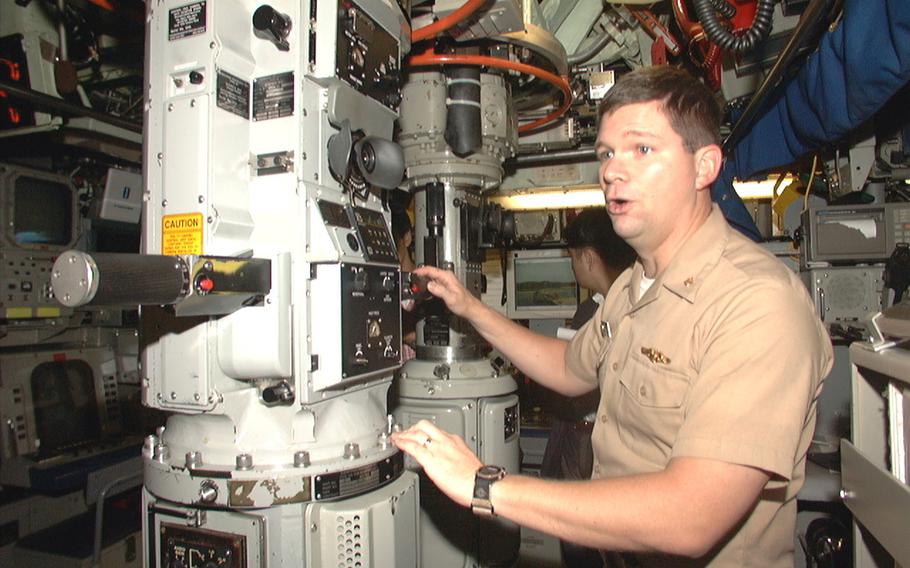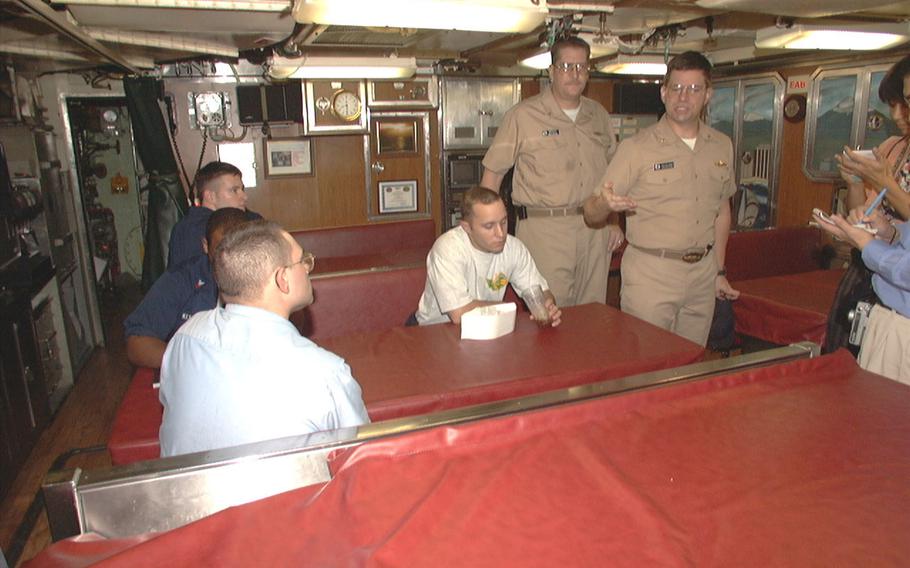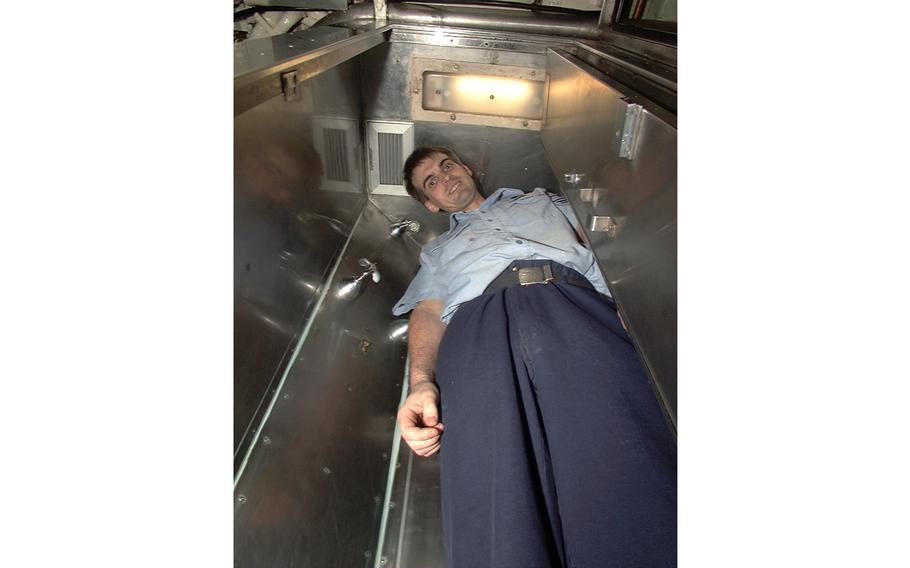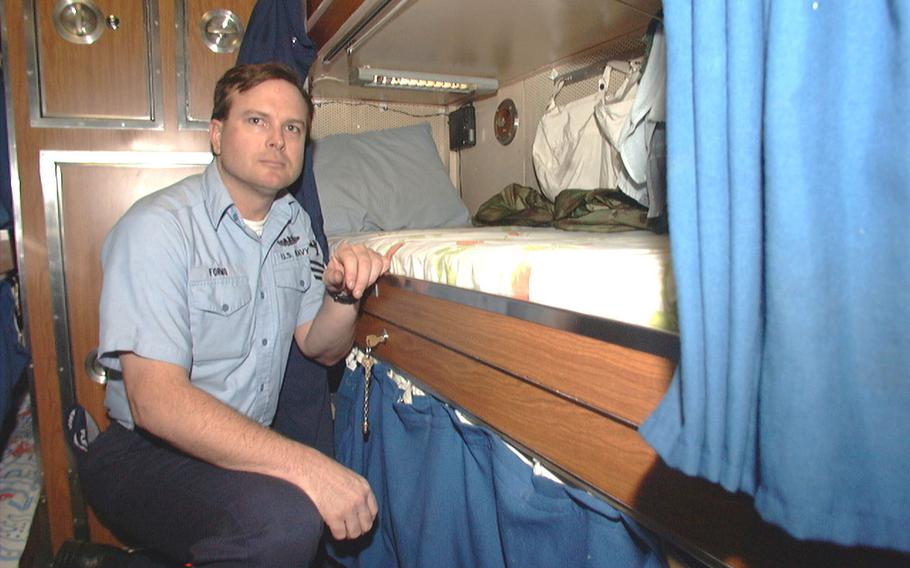
Navy Lt. Cmdr. Eric Holloway, executive officer for USS Bremerton, explains how the submarine periscope operates. USS Bremerton stopped at White Beach Naval Facility during Annual Exercise 2001, a bilateral training exercise with the Japanese Maritime Self-Defense Force. (Mark Oliva/Stars and Stripes)
This article first appeared in the Stars and Stripes Pacific edition, Nov. 12, 2001. It is republished unedited in its original form.
Petty Officer 1st Class Erik Formo dreams about steak dinners, a bed to himself and hot showers.
“Two weeks before we get anywhere, we constantly talk about what we’re going to eat,” Formo said. “I usually have a list of my meals for the first week home.”
Aboard the USS Bremerton, a nuclear-powered Los Angeles Class attack submarine, Formo has little else to do in his off time.
He’s part of the Navy’s silent service, spending weeks and even months cruising the ocean floor with 130 other sailors.
Formo offered a glimpse inside the life of a submarine sailor while at White Beach Naval Facility on Okinawa during Annual Exercise 2001.
Formo was born to be a submariner. Both of his grandfathers were submariners in World War II. He’s served on submarines for 14 of his 16 years in the Navy. For a time, he worked aboard a destroyer tender, but it didn’t compare to his sub tours.
“One of the biggest pros is I work with a better class of people,” he said. “There’s a tighter camaraderie. We’re all pretty close.”
Close on a submarine carries a different meaning than the rest of the Navy. USS Bremerton is only 362 feet long and 33 feet wide at its widest point, but that’s not all living space.
Much of the submarine is occupied by the nuclear reactor that drives the boat. The nose of the submarine houses advanced sonar detection equipment, a combination of 22 torpedoes and Tomahawk cruise missiles, and the four 21-inch tubes that launch them.
Not an inch of space is wasted on the Bremerton.

Navy Lt. Cmdr. Eric Holloway, executive officer for USS Bremerton, explains how busy the mess decks are for the 130-man crew. (Mark Oliva/Stars and Stripes)
The submarine makes its own water and recycles air, so the limiting factor of how long they can stay underwater is the amount of food they can carry — around 90 days’ worth.
Even the submarines’ mess decks, arguably the largest open space on the submarine, double as storage areas. Food stores are stuffed into the benches where sailors sit to eat.
But that’s not the only use for the six-table room. It doubles as a classroom, an entertainment area and whatever else the crew needs.
“This is like the living room in your house,” said Lt. Cmdr. Eric Holloway, USS Bremerton’s executive officer. “All over the submarine, we store food. As the deployment goes on, we gradually eat our way down.”
The cooks serve four meals a day, while the crew works 18-hour shift cycles, never seeing the days pass, but always knowing how many days are left before reaching home port.
“Everybody tracks the days, but it’s not worth it,” Formo said. “It’s like the movie ‘Groundhog Day’. It’s the same thing over and over.”
The Pearl Harbor-based crew’s deployments are six-month missions across the Pacific. They stay hidden most of the time, location known only by the crew and the Pentagon’s selected top brass.
“We start off with a schedule, but the deployments never stay on schedule,” said Petty Officer 1st Class Matthew Gray. “We have a lot of underway time. On this deployment, in our first three months, we had five days off. We’re supposed to be out for six months and in port for 18 months. But it usually gets bumped up. It normally runs about six months out and 12 months in port.”
That schedule is particularly tough on Gray’s family. He leaves a wife and four children each time USS Bremerton sails.
“There’s no way to contact anybody,” Gray explained. “There’s no getting a hold of your family. My youngest kids, they don’t understand. My 4-year-old won’t talk to me on the phone when I call from a port. I’m sure it’s tougher on my wife than me.”

Navy Petty Officer 1st Class Matthew Gray demonstrates the frustration he faces forcing his more than six-foot frame into the small showers of USS Bremerton. (Mark Oliva/Stars and Stripes)
The long periods of silence hit the crew hard. Formo said on one recent deployment, two crew members didn’t find out about significant family problems until they were two days from pulling into Pearl Harbor.
Sailors assigned to surface vessels often tell the submariners they would consider life on USS Bremerton unbearable.
“People always say ‘I couldn’t stay under the water that long,” Gray said, “especially when they hear about the extended runs where food starts to go downhill. I don’t think they understand. They’d have to come down and do it.”
The Navy’s submariners are all volunteers, choosing to spend their tours under the ocean’s surface. But that all-volunteer force is a bit of a misnomer, Formo said.
“We are an all-volunteer force,” he explained. “But once you volunteer, you can’t un-volunteer yourself. You’re designated submariners, and your job from then on is to work on subs.”
“For me, I don’t mind,” Formo added. “I’ve been on a destroyer tender and it was nice to see sunrises and sunsets, but I believe the people down here are better. It comes down to how long do you think you can tolerate it. I’ve got five more years. I think I can do it.”
But with limited space, cramped quarters and never knowing what’s going on outside, sailors find ways to make their life a little cozier.
“You pack the essentials,” said Petty Officer 2nd Class Emmanuel Soriano. “Plenty of underwear and socks are part of the essentials. So are toiletries and lots of extras, because you never know if you’ll run out. We pack a minimum of three sets of coveralls, a couple of dungarees and our dress uniforms. Throw in a couple of sets of civilian clothes for port calls, and we’ve pretty much filled up our storage spaces.”
Their bunks, or racks in naval terminology, are stacked three high, with barely enough room to stand in the middle to get dressed. The racks, only about two-feet high and six-feet long, also double as the sailor’s individual storage area. There are 117 racks on USS Bremerton, for a crew that can be as many as 140, meaning, some sailors have to “hot rack,” or share their beds while they’re on duty.
“The storage area we have is about three inches deep,” Formo said. “It’s just enough so that a soda can fits in perfectly.”
Formo fills what little space he has left with Halloween candy, a comfort food he doles out to the crew.
“Everybody has a CD player,” Soriano added. “It helps to block out everything else and gives you your time.”

Navy Petty Officer 1st Class Erik Formo shows off his rack aboard USS Bremerton. This is the only space Formo has to call his own, for sleeping, storage and relaxation. (Mark Oliva/Stars and Stripes)
Cramped quarters and ship-life frustrations sometimes make time alone a precious commodity. Gray, towering well over 6-feet tall, has to duck under almost everything, including when he showers in a stainless steel stall that’s about five inches too short for his frame. The shower nozzle hits him at neck level.
“Everybody gets tense toward the end,” Gray said. “People are tired of looking at the same old faces. You learn not to talk to anyone for the first half hour or so after they get up.”
But the frustrations rarely boil over.
In his 14 years under the sea, Formo can only remember two cases where frustrations came to blows.
“And only one of those was a case where punches were thrown. They were two best friends, and one guy just said something wrong and the other popped him.”
But that’s where it ended.
Gray said the people who can’t handle life on a submarine are usually weeded out, finding shore-based duties or opting out of the Navy.
Frustrations aside, none of the three sailors said they would choose duties elsewhere if they could.
Gray has served on attack submarines such as USS Bremerton as well as the Navy’s “boomers,” the Trident nuclear submarines carrying intercontinental nuclear missiles.
USS Bremerton is Soriano’s first submarine, but he wants to stay because of the increased responsibility and better chances for earning qualification badges and promotions. Formo, who tallied time on surface vessels and a tour on shore duty, said he expects to remain in the deep until his retirement, just a few years away.
“I’d still do it,” Formo said. “It’s just a different attitude in the surface fleet. I don’t feel like I could just walk up to one of the chiefs and shoot the breeze.”